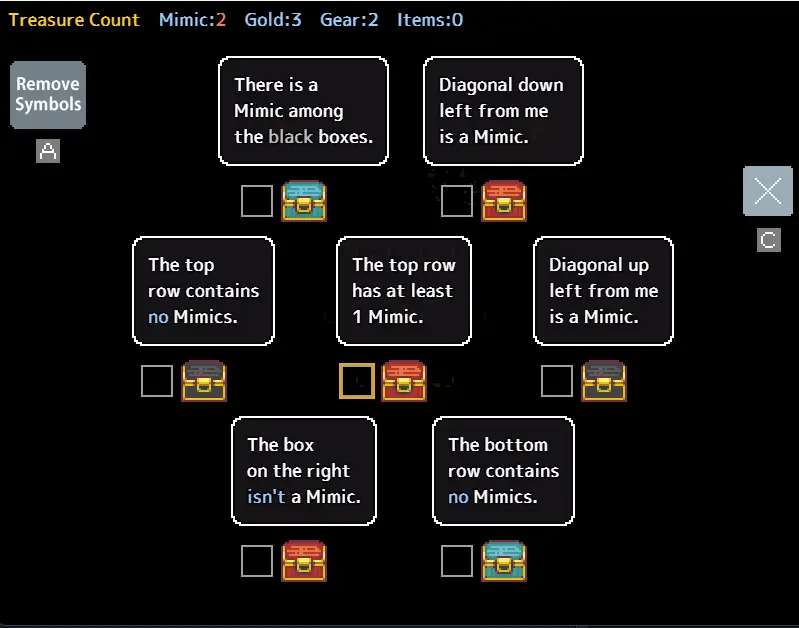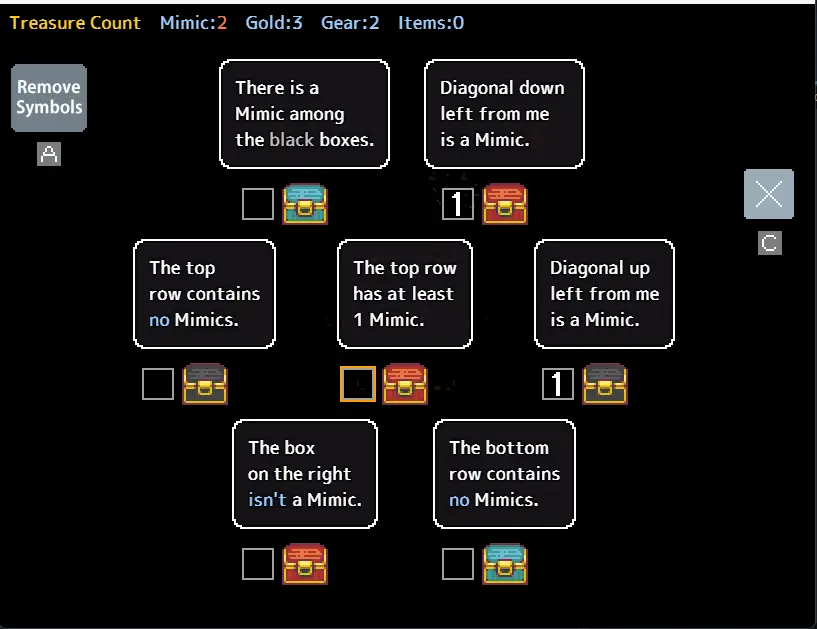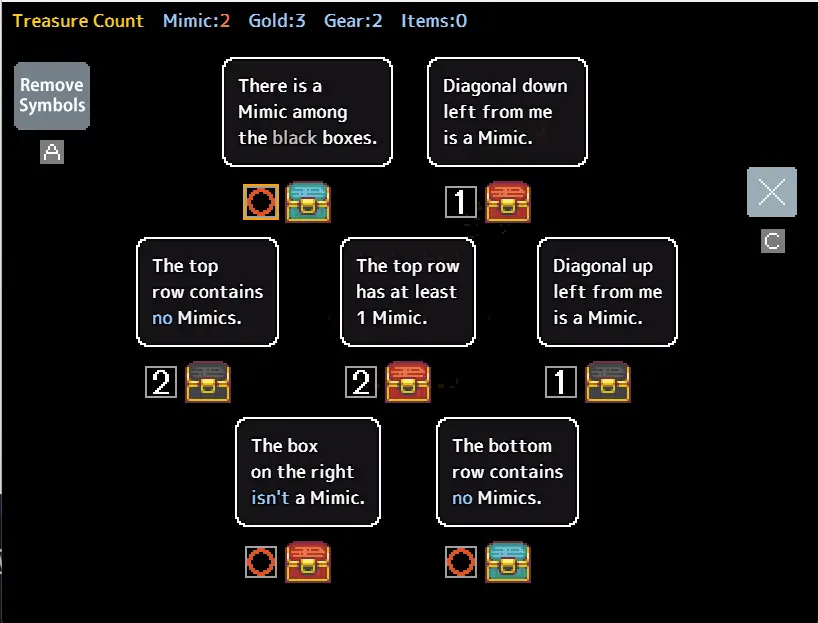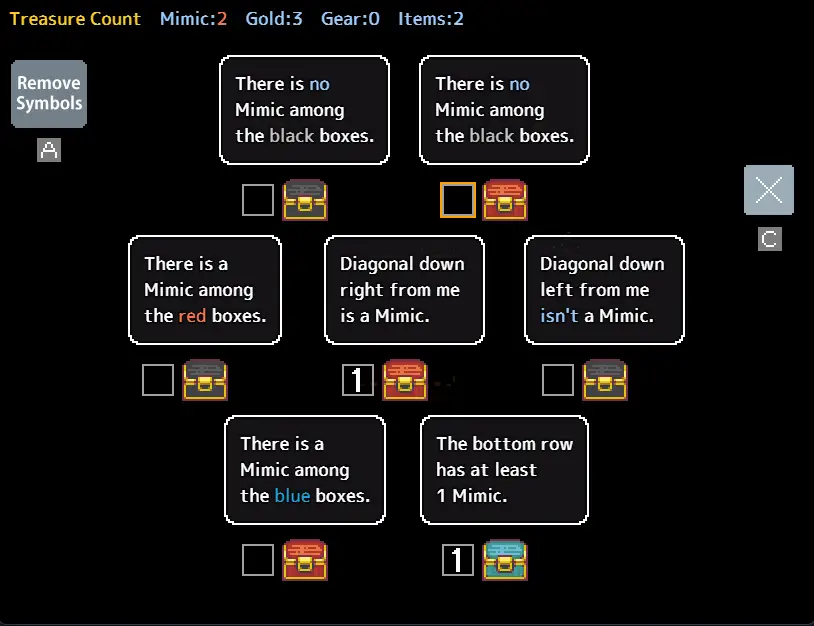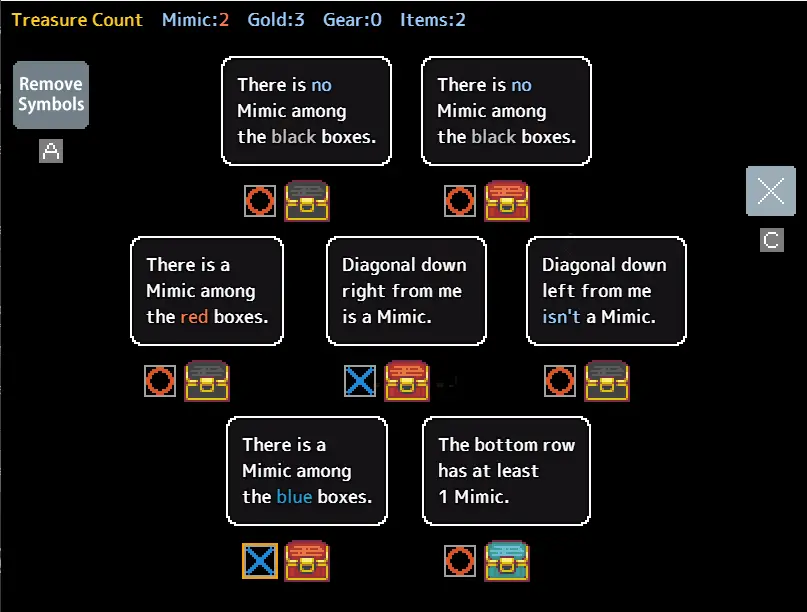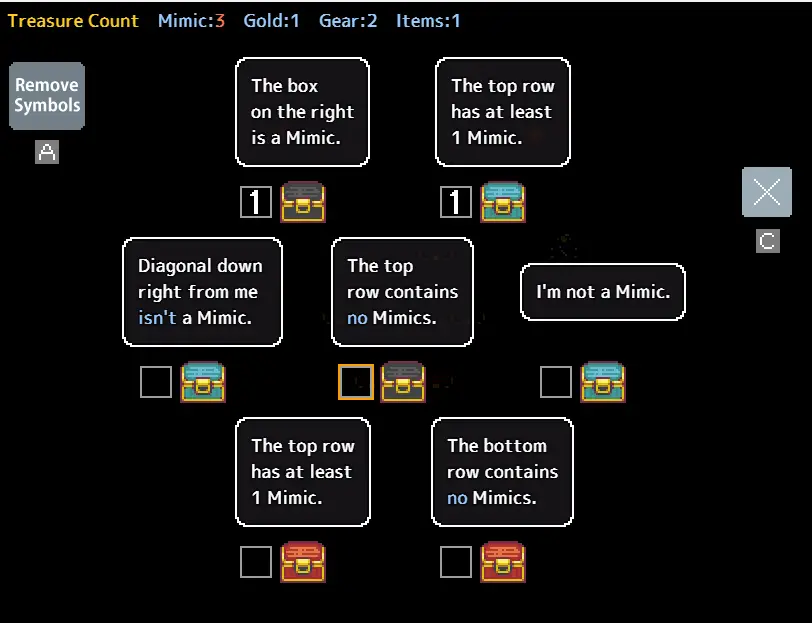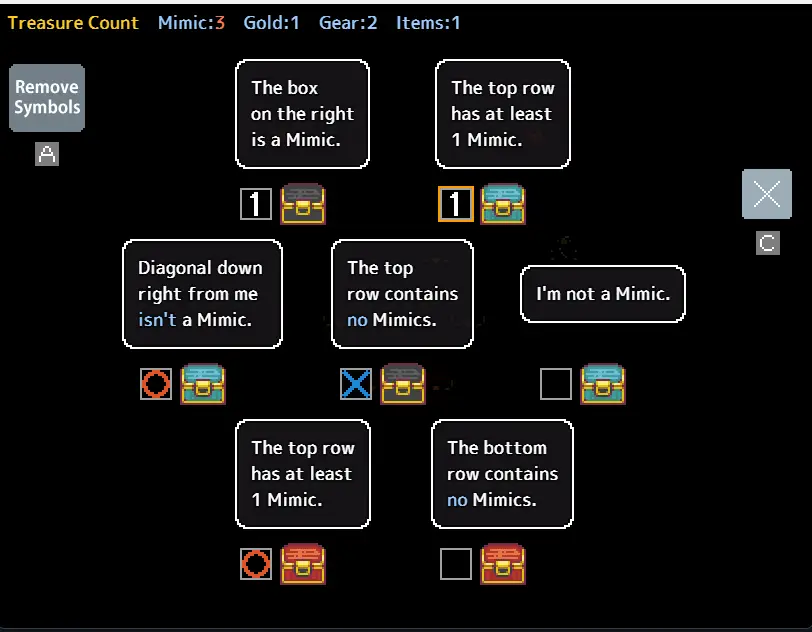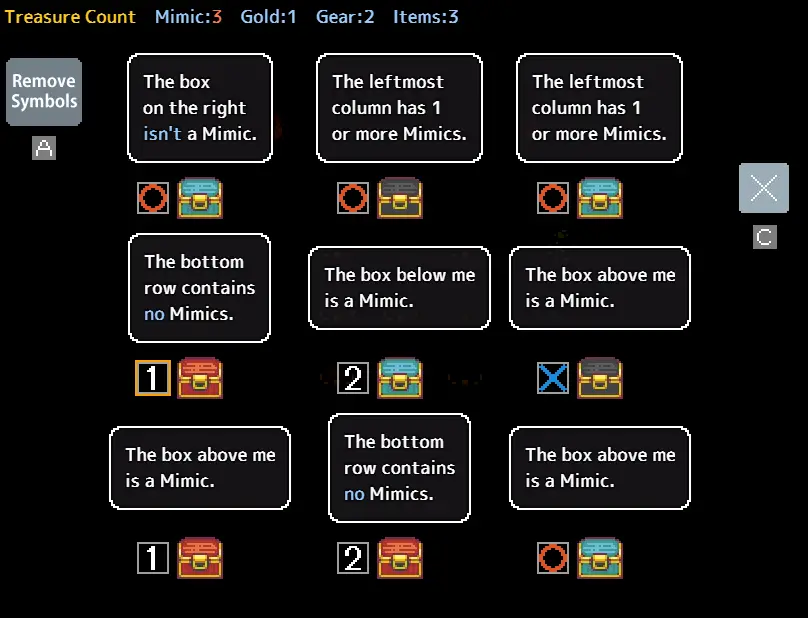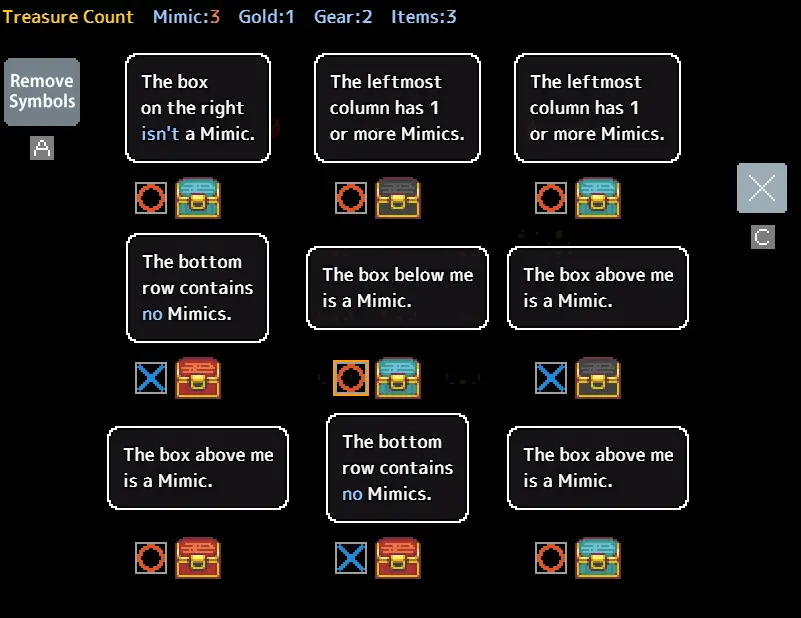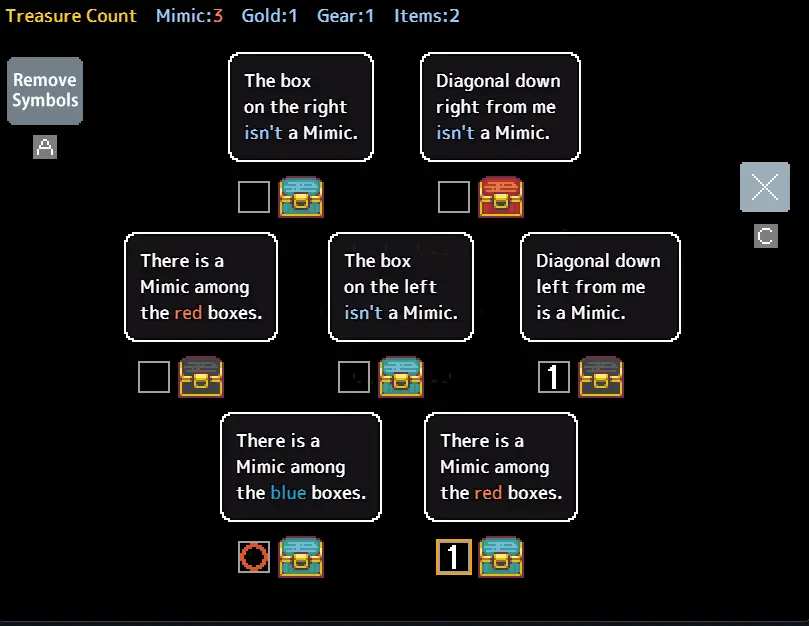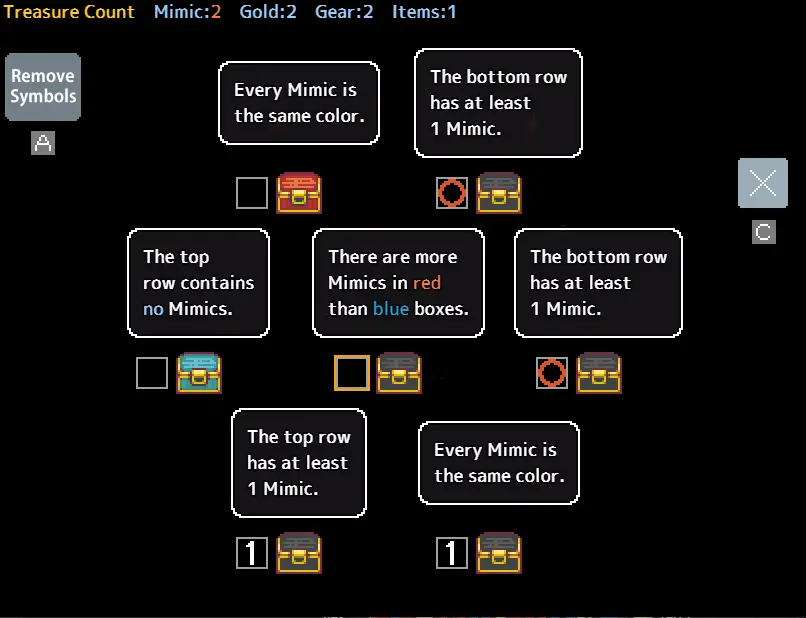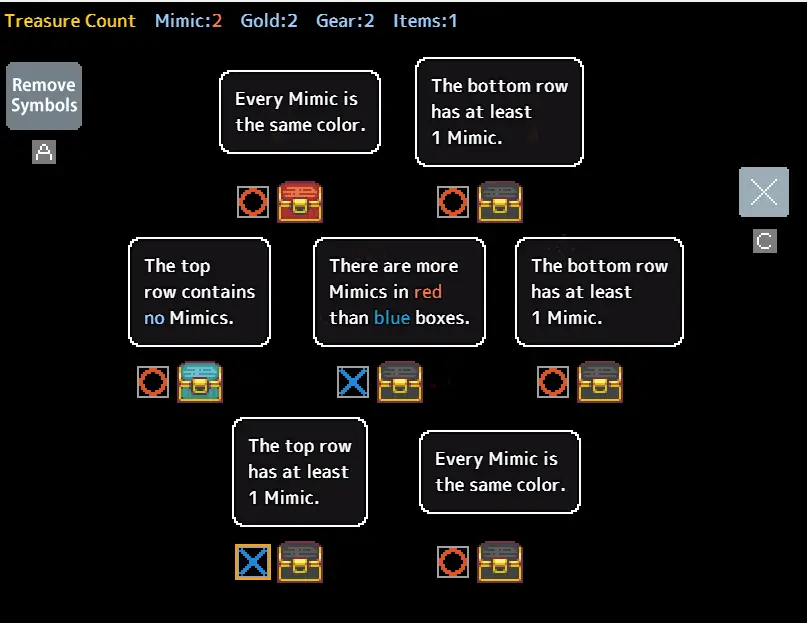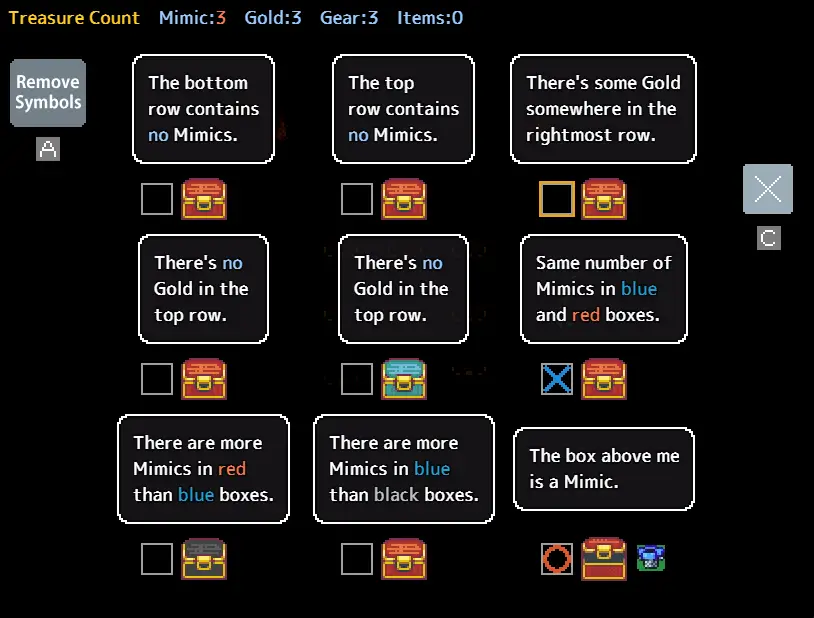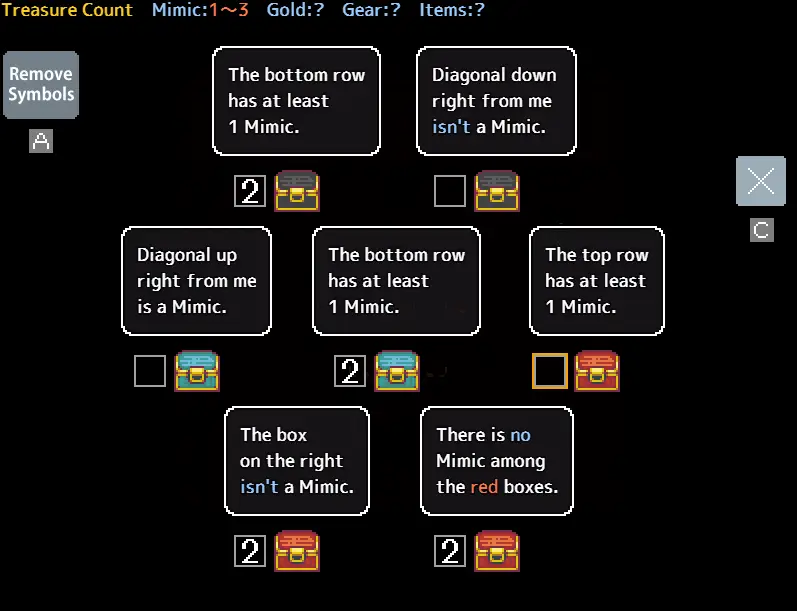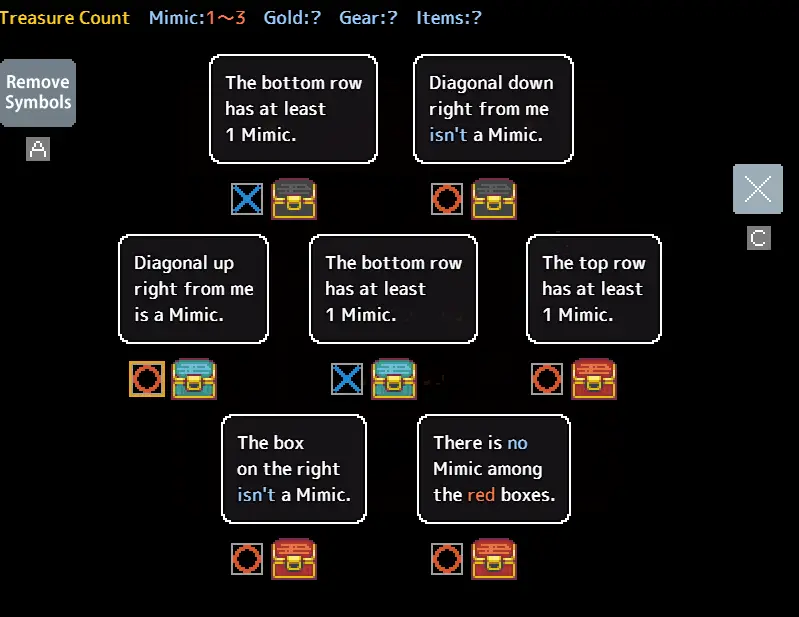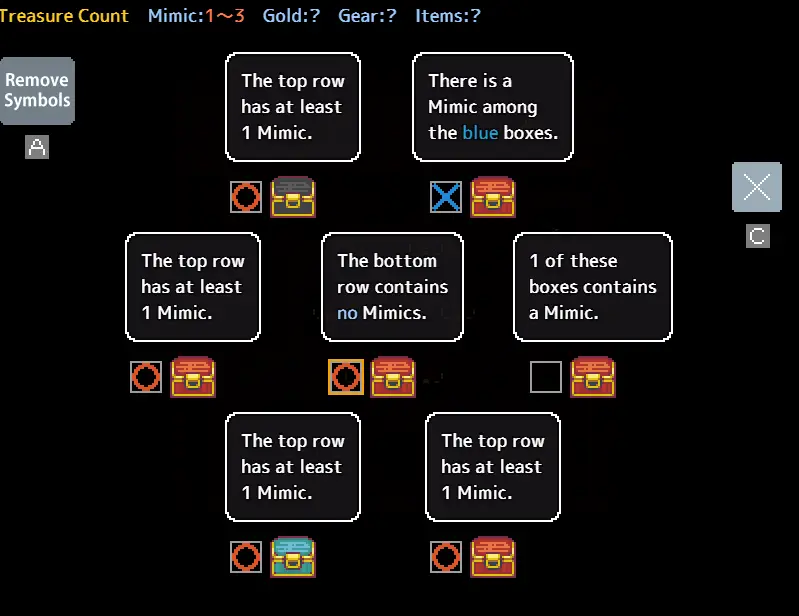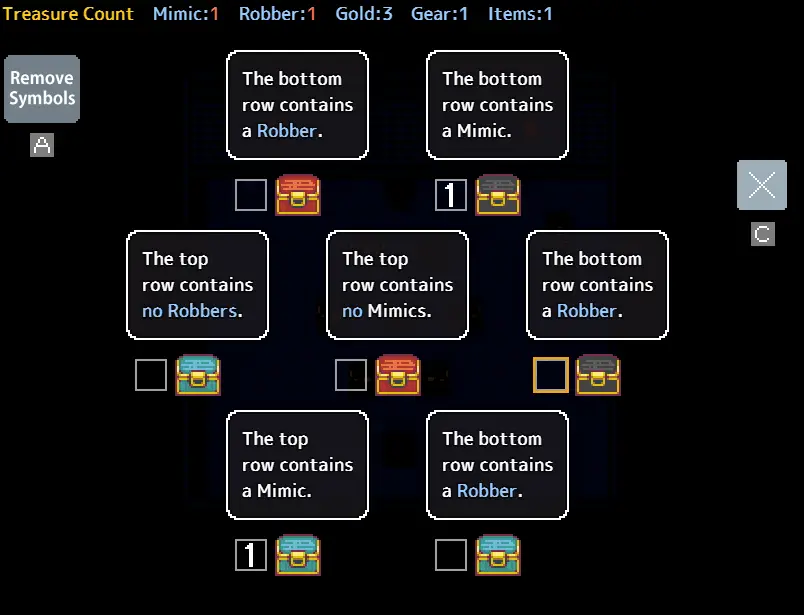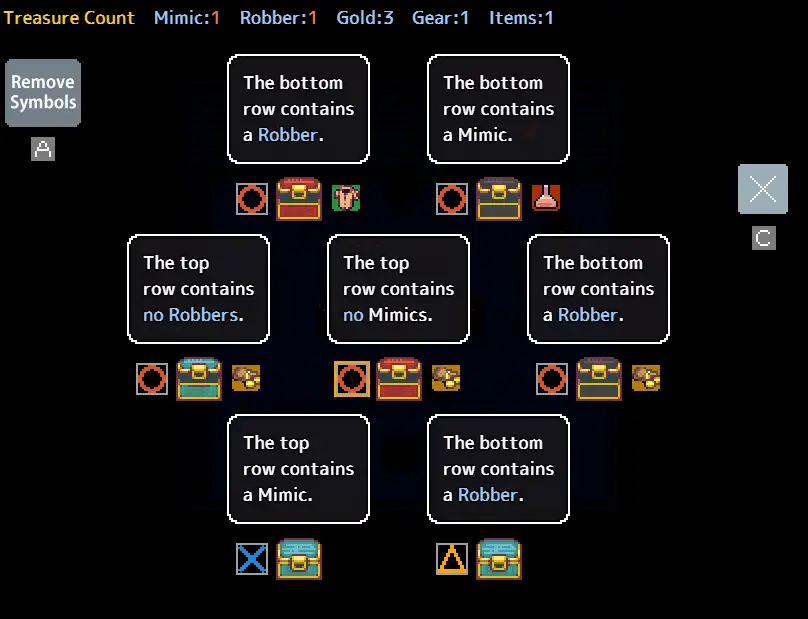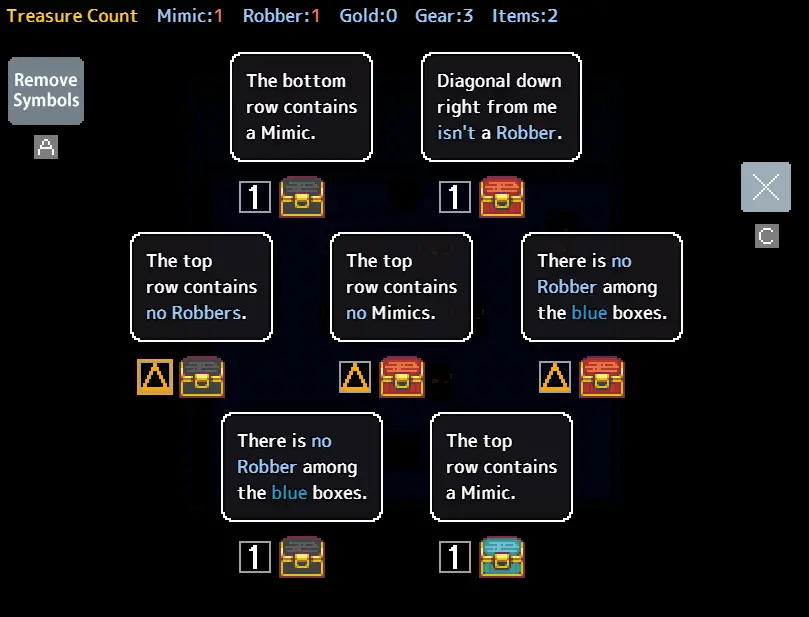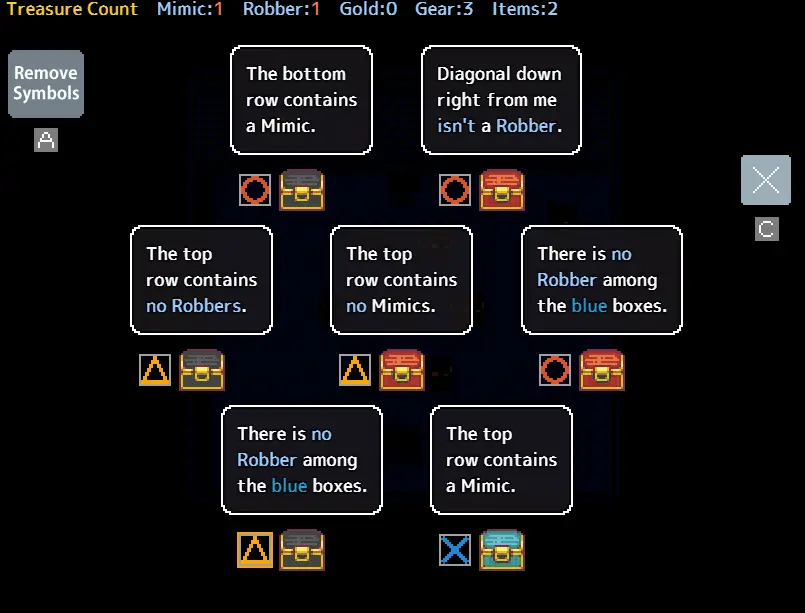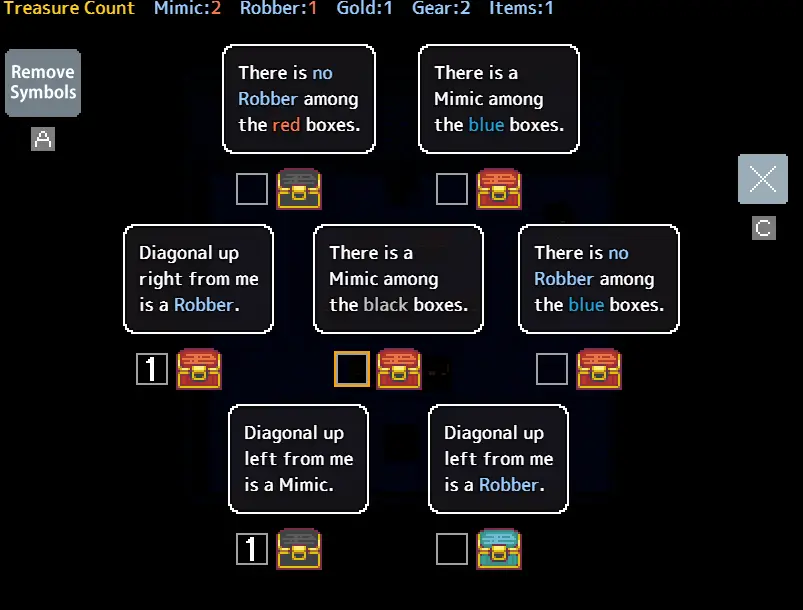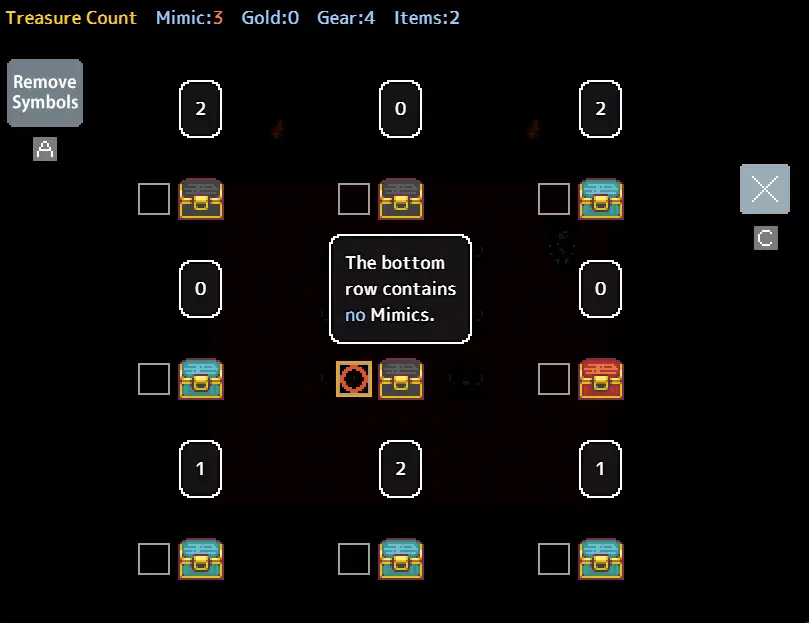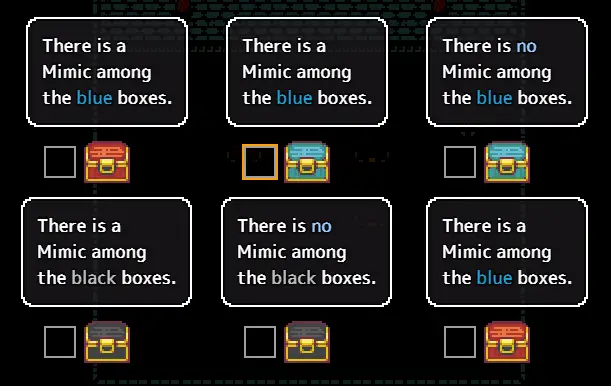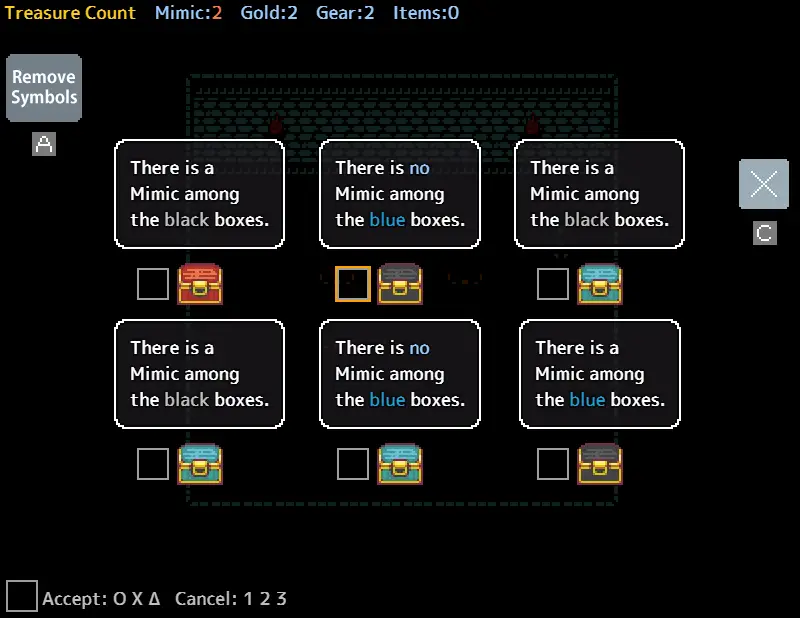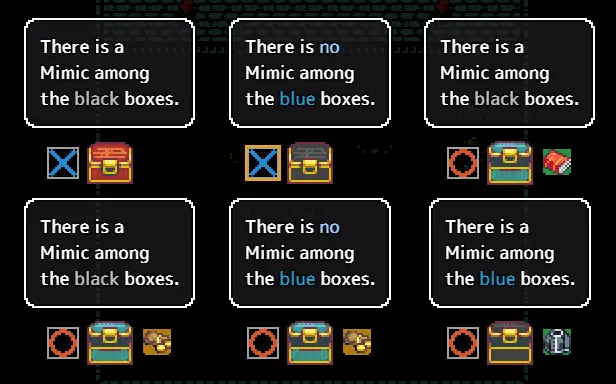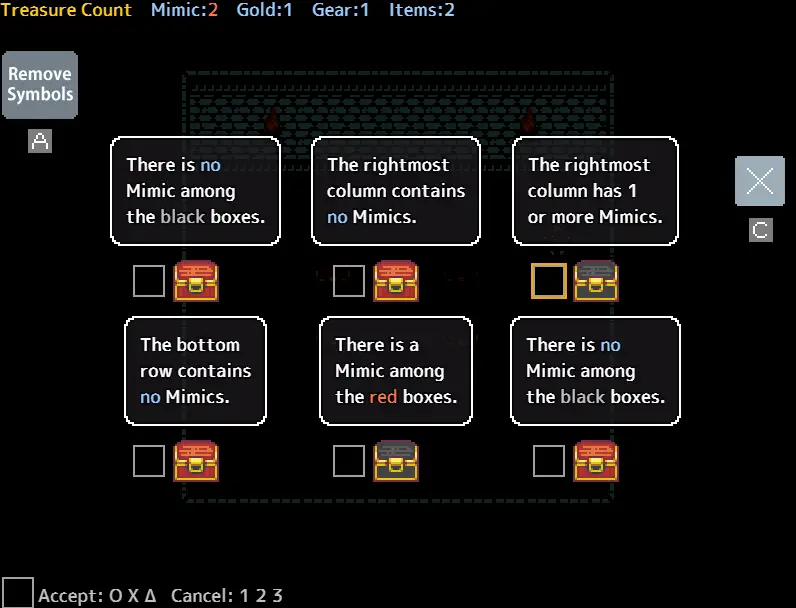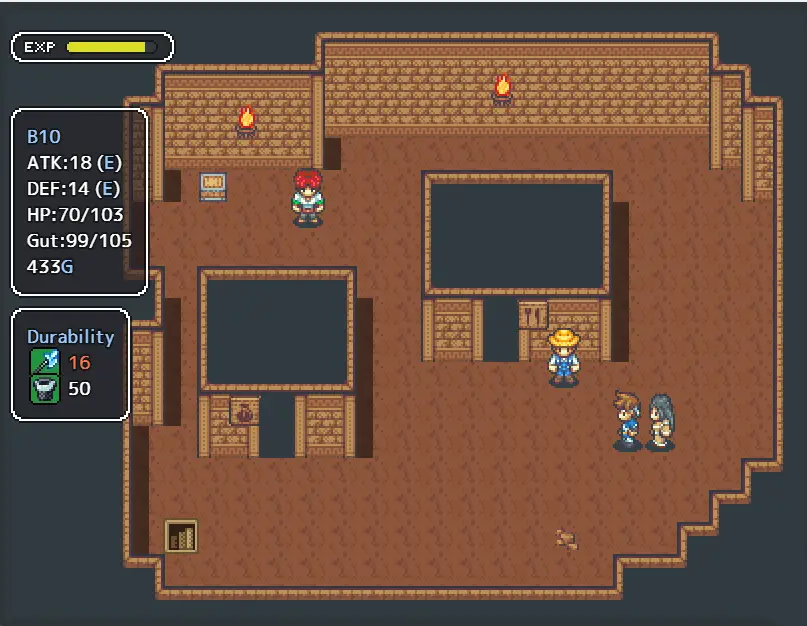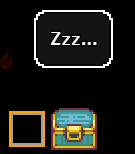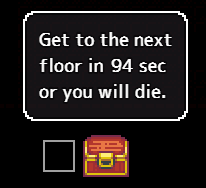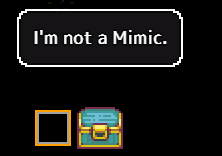A basic list of tips for Mimic Dungeon for finding those pesky mimics
Forward
Welcome to my Guide for Mimic Logic. In this Guide I hope to arm you with all the knowledge you will need to beat every dungeon. In this guide is a collection of my “best practices” as well as some example puzzles. due to the random nature of the game I can’t give specific solutions, but instead general strategies to solve every puzzle.
General Tips for all Dungeons (except doubt and Confuse)
- mimics cannot self report
- if a chest claims that an adjacent box is a mimic, either the Box it claims is a mimic is a Mimic, or the Chest is lying
- While Hunger might feel pressuring, it usually isn’t an issue. if you starve often, invest in hunger upgrades
- sometimes there are multiple valid solutions. in those cases it’s usually better to just grab chests that are guaranteed to not be mimics and skip any 50/50 chests/
- usually the best shop items to buy are the attack and defence candies
- If the same statement is repeated more times than the number of mimics, it must be true
- Sometimes Mimics are really dumb. Things like claiming there are 2 mimics in black chests when the puzzle only has a single black chest
Standard dungeon and general mimic finding guide
Welcome to your first Dungeon. The standard dungeon has the fewest mechanics to worry about, with every chest room usually (but not always) being not too difficult to solve. Unless otherwise stated, every dungeon follows these rules:
- Mimics always lie, non-mimics always tell the truth
- each dungeon floor gives the exact mimic and loot count
- every 10 floors is a town, except for the last floor
Mimic Pairs:
With that background info, lets look at the most useful strategy for this and most other dungeons, mimic pairs.
A mimic Pair is a set of chests that has to include at least one mimic. For example, if a chest says that the Chest on the left is a mimic, either the chest on the left is a mimic, or the Chest is lying and it is a mimic. either way you know the location of one of the mimics. Using mimic pairs allows you to break down larger puzzles into smaller ones. Any time two or more chests give conflicting statements, at least one must be a mimic.
Lets take the following Standard Dungeon puzzle as an example:
While seven chests might be a little overwhelming at first, this puzzle gives us a very good mimic pair to work with. The middle right chest claims the chest above it is a mimic, forming a mimic pair. Now we can mark both of them (I use a 1, use whatever number you like)
so instead of doing a 7 chest 2 mimic puzzle, we can ignore the pair and treat the rest of the puzzle as a 1 mimic 5 box puzzle
The joy of 1 mimic puzzles:
One mimic Puzzles are quite easy to solve, due to the following:
- any chest claiming an adjacent non-marked box as not a mimic must be telling the truth, since if it was lying that would make the Puzzle have too many mimics
- Mimics still Cannot self report
Let’s continue the example from above. looking at the 5 unmarked boxes, the one on the bottom left is claiming that the box to the right of it must be true. this box must be telling the truth, since if it was lying both it and the box next to it would be mimics, which would mean our puzzle has 3 mimics, which cannot be true. Therefore we can mark both the boxes on the bottom as real.
While we are at it we can also mark the 2 middle boxes as a pair, as both of their statements cannot be correct. this also means that the last unmarked box must be real, since both mimics must be in the pairs.
Finishing it all off:
once all mimic Pairs are marked and all easy real chests are found, the following can be used to finish the puzzle:
- All real chests statements that haven’t yet been marked can be marked
- all remaining mimic pairs that interact in some way can be used to deduce where the mimic is in each
the 50/50 conundrum:
sometimes you are left with pairs that have multiple solutions. in our example there are 2 possible solutions. either the top right and middle left chest are mimics, or the middle and middle right chests are mimics. in cases like these, open all safe chests, then leave. if you have a blue orb you can use it to break the 50/50 after you open all safe chests. Otherwise, just leave. the 40 gold is not worth it.
But what if I have no pairs?
sometimes a puzzle will have either no pairs, or not enough pairs. In those cases, there are other quick strategies that can be used.
Duplicated statements:
Take the following puzzle
In it there is a single marked mimic pair, but no other easy to find pair. However the puzzle has also given us a huge hint by having both top chests have the same statement. If more chests are making a statement than there are unmarked mimics, that statement must be true. using the previous example, we could mark the two top chests, then the black chests, then the bottom right chest, leaving 2 remaining chests where the mimics are
Pair Positioning:
consider the following Puzzle:
3 mimics, two pairs (only one of which is marked). however in this case the location of the pair allows us to solve this puzzle. since there must be at least 1 mimic in the top row, the chest that claims the top row has no mimics is lying and is therefore a mimic. similarly, the chest that says the top row must have at least 1 mimic must be telling the truth, which allows us to easily mark the following:
you can then mark the chest in the top pair that says the top row must have at least 1 mimic as true, the other one on top as a mimic, and leave the last 2 as it’s a 50/50
Expert dungeon Guide
Welcome to the Expert dungeon. for the most part the strategies are the same as the standard dungeon, just with a few new chest types. So instead of repeating all of those I will instead go into the new chests and a couple more advanced strategies.
Truth Chains:
consider the following puzzle:
In it we have solved all the easily solvable chests, leaving us with 2 pairs remaining. In situations like this simply getting to a Solution may lead as down the wrong path, as some puzzles have multiple valid solutions. The technique I like to use is what I call a truth chain, although trial and error would be another title for it.
The basis for a truth chain is “what happens if X is true or false?” The easiest place to start in this puzzle is with the statement “The bottom row contains no mimics” as 2 Chests are saying it, meaning either they must both be real or mimics.
Lets start with the assumption that they are both telling the truth. we would mark them both as true and also mark the other chest on the bottom as true. this would leave us with 2 mimics when the puzzle has 3, meaning this solution isn’t correct. Therefore “The bottom row contains no mimics” must be a false statement.
Do note that if your first assumption produces a Valid solution,
do not immediately assume it is correct
. you must then test the opposite. Sometimes both solutions are correct, leading to a gridlock.
Gridlocks
look at the following puzzle:
This puzzle is unsolvable. Using a truth chain on the two boxes that claim the red box is a mimic leads to 2 valid solutions. either the red, middle right and top left boxes are mimics, or the bottom right, middle left, and middle boxes are mimics. Sometimes you just need to move on
Color based deduction
look at the following puzzle:
in it there is a set of clashing statements. the statements “every mimic is the same color” and “there are more mimics in red than blue boxes” cannot both be true. leading to one of two possibilities. either both of the boxes claiming that the mimics are the same color are lying, or they are both real and the remaining 2 black boxes are mimics. In either case the blue chest must be real, and we can mark it. we can then use the true statement from the blue chest to solve the puzzle.
Gold Logic
Consider the following puzzle:
Since both the other chests on the right were solvable, and since neither one contains gold, the chest in the top right becomes very important. using a logic chain, we can see the if it’s lying, it would lead to too many mimics. therefore it must be real and contains gold. This means that both chests saying “There’s no gold in the top row” must be lying
Random Dungeon Guide
Random dungeons are the first time the game shakes up the rules a bit. instead of giving you an exact chest count, you get a range for the number of mimics. Usually this leads to the safest strategy being to treat each puzzle as if it contained the maximum amount of mimics. However some strategies involving mimic counts become less reliable.
Basics of randomness
Consider the following puzzle:
due to how this is set up, either both bottom chests are mimics or both chests claiming at least one of them are. however we are still left with a problem. we don’t know if 2 or 3 chests are mimics.
We can however, confirm that the middle right box is telling the truth. if it is lying then the box up-left from it is also lying, creating a situation where there are 4 mimics. marking this box as true allows us to solve the puzzle and see that there are 2 mimics.
Single box 50/50
Random Dungeons can have single box 50/50 chances as in the following:
In this puzzle the unmarked box may or may not be a mimic. since we don’t know the mimic count, we can’t tell if it’s telling the truth and there is only one mimic, or if it’s lying and it’s the second mimic.
Robber Dungeon Guide
Robber Dungeons include a new type of chest, the robber. This chest always tells the truth, but if opened steals 100 gold from you. if you have less than 100 gold it just steals as much as you have. Because of this, testing possible robber chests when you have very little gold (such as at the start or after a shop) is usually better than using the open all button.
Getting robbed for profit
Look at the following puzzle:
while a bunch of chests are concerned about the robber, the two most important ones are the marked pair. one of those is the mimic. additionally, the bottom row must contain the robber. Therefore all non marked non bottom chests are safe. this means that the chest saying the top row has no mimics is true, leaving us with both the mimic and the bottom chest as being unsafe to open (one is the robber, one is the mimic)
eyes on the prize
Consider the following:
after marking the first round of mimic locations, the 3 middle chests are immediately truthful. this means the top chests are safe, the and the blue chest is the mimic. following this, we arrive at this solution:
What you do next depends on your gold count. if you Just visited a shop or just started you should open the triangle marked boxes one at a time until you find the robber. since none of the chests contain any gold you will be able to open all of them without fear of the robber taking any. If you have 100 or more gold, then you need to weigh the value of 2 items/equipment against 100 gold. this is largely subjective so it’s up to you.
robber reports
In a 1 mimic situation, a chest reporting the location of a robber guarantees a non mimic chest, such as in the following puzzle:
In this puzzle, the bottom right chest claims the middle is the robber. since one mimic is already in a mimic pair, the middle chest must not be the mimic. as either the bottom right chest is telling the truth, or it is a mimic, and lying about a normal chest being the robber. Similarly, the chest on the middle right must also be telling the truth, since if blue was a robber they would not be able to lie about their location.
I am not the robber
If a chest ever says it is not the robber, such as claiming red chests have no robbers when it is the only red chest, it cannot be the mimic or the robber. The robber can’t lie, and a mimic would lie and say that a red chest was the robber.
Number Dungeon Guide
Welcome to the minesweeper dungeon. While the number dungeon initially might seem daunting, it’s not that bad once you get a basic understanding of how to navigate it. Most boxes have a number, that number is how many mimics are near them, counting diagonals.
how does this number thing even work?
A number on a box means that there are X mimics nearby, X being the number. So a box with a zero is telling you all nearby chests are safe, while a four would mean there are four mimics nearby. however due to each puzzle always being three by three, a basic strategy is fairly easy to do.
Go for the Centre
checking the centre box allows you to solve many of the number puzzles, take this one for example:
In this puzzle the centre box must be real. if it was a mimic, the three 0 boxes would also be mimics. that would leave us with 4 mimics, which is Impossible.
Check the corners
If a 3 Box is in a corner, it means that either all the boxes surrounding it are mimics, or it itself is a mimic. usually it isn’t too hard to figure out which one it is.
Doubt Dungeon Guide
Welcome to the Dungeon most likely to give you a headache. The doubt dungeon flips the rules on their head by having mimics always tell the truth, while all-non mimic chests of the same color as a mimic lie. This means that many of the normal strategies will not work. However, once you wrap your head around this new ruleset, there are a few new strategies that you can use to quickly find the mimics.
Color Based Self reporting
Unlike the dungeons before it, mimics self report in doubt. Take the following puzzle:
The Black box in the bottom left claims there is a mimic among the black boxes. This box must be a mimic, as only a mimic is able to self report in Doubt dungeons. Same goes for the top middle blue box.
reverse self reporting
similarly, if a chest claims it is not a mimic, it must not be a mimic, although it might be lying, as in the following:
In this puzzle, the bottom middle chest cannot be a mimic, if it was, it would tell the truth that there is a mimic among the blue boxes.
Single Color statements
Continuing from the puzzle above, the red chest must be telling a true statement. If a chest is the only chest of it’s color, the statement it says must be true. Using this, we can mark the blue boxes all as true (since if both were lying we would have 3+ mimics), then mark the red box as a mimic, as only one black box can be a mimic, then finally mark the top middle box as a mimic, as it is telling a true statement, and whichever black box is telling the truth is a mimic.
Location based self reporting
In order for a mimic to be “self reporting”, all possible mimics of that color must be included in their statement. Take the following:
While at first glance you might think the mimic in the top right is self reporting, This is not the case. since all possible black mimics aren’t in the right column, it could be a real box that is lying. In this specific puzzle it is real and is telling the truth.
Confuse Dungeon Guide
Welcome to the final dungeon of the game. Confuse dungeons don’t need their own dedicated strategies, just a modification to the rules we use.
Here’s a quick list of rules in confuse dungeons:
- statements said more times than there are mimics + confuse chests must be true
- true statements mean the chest is real
- a chest being real does not always mean it’s statement is true
- puzzles can be treated as containing one more mimic for the purpose of mimic pairs
- if you hit the maximum number of mimics/mimic pairs, all remaining chests must be telling the truth
- in one mimic/confused box situations, all rules that apply to one mimic dungeons work, treating confused boxes as the only mimic
- blue orbs are very useful for cracking open later puzzles, 50/50 situations are also much more common, so try to not use them on every 50/50 you find
- A chest that self reports must be real
Basic Town Overview
A town is a Location that spawns on floor 10 and floor 20. A town will always contain the following:
- NPC with 1 tip
- restaurant that sells two different gut and hp restore meals, one that is a full heal, and one that is a small heal
- A shop that contains a shopkeeper
Towns also have the chance to spawn one of the following NPCs:
- Strange Doctor: gives you medicine that can either heal you or damage you 30hp
- lottery ticket salesman: sells you a scratch ticket for 200 gold. The prizes are 1100 gold for 1st, 400 for second, and 300 for third.
- Blacksmith: will restore 10 durability on your weapon and armour for 10 gold.
Notable Chests
The following is a list of noteworthy chests:
Sleepy Chest
A sleeping chest is just that, sleeping. You can wake them up using a specific item, otherwise they will provide no useful information
Countdown Chest
A countdown chest comes with a timer that counts down from 100. If it’s real you will die when time runs out. If it’s lying nothing will happen.
“Innocent” Chest
Chest that claims it is not a mimic. on most Dungeons this provides no useful information. In Doubt dungeons it allows you to mark all chests of that colour as real. In confuse dungeons it lets you know it isn’t confused
End
Thanks for taking a look, I hope something here helps. If you have any strategies or patterns that I missed feel free to add them in the comments and I can add them to the guide (with credit of course)


